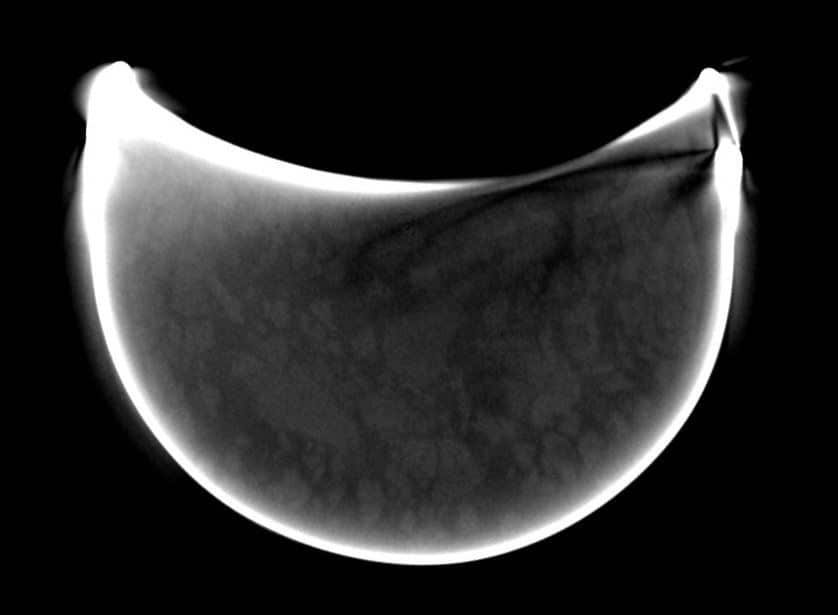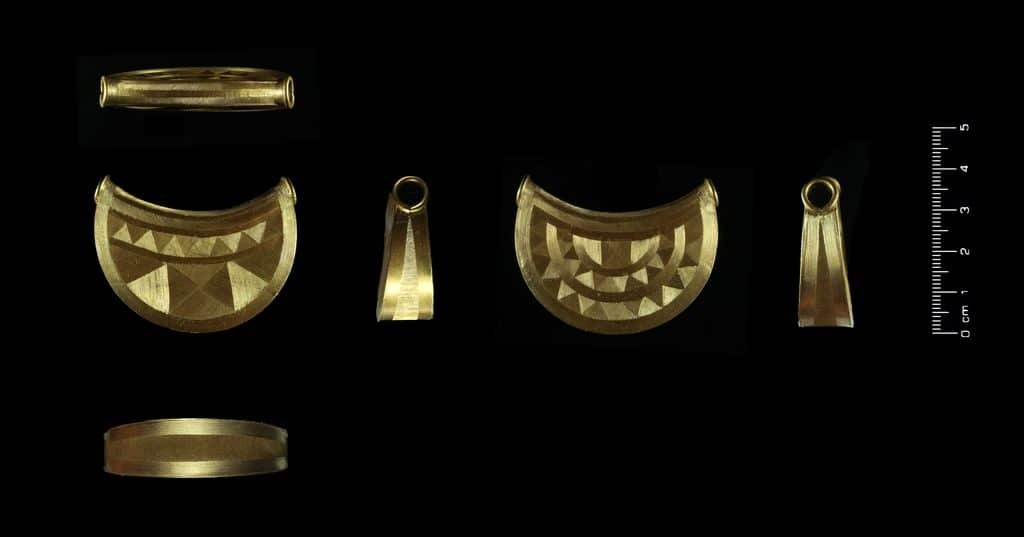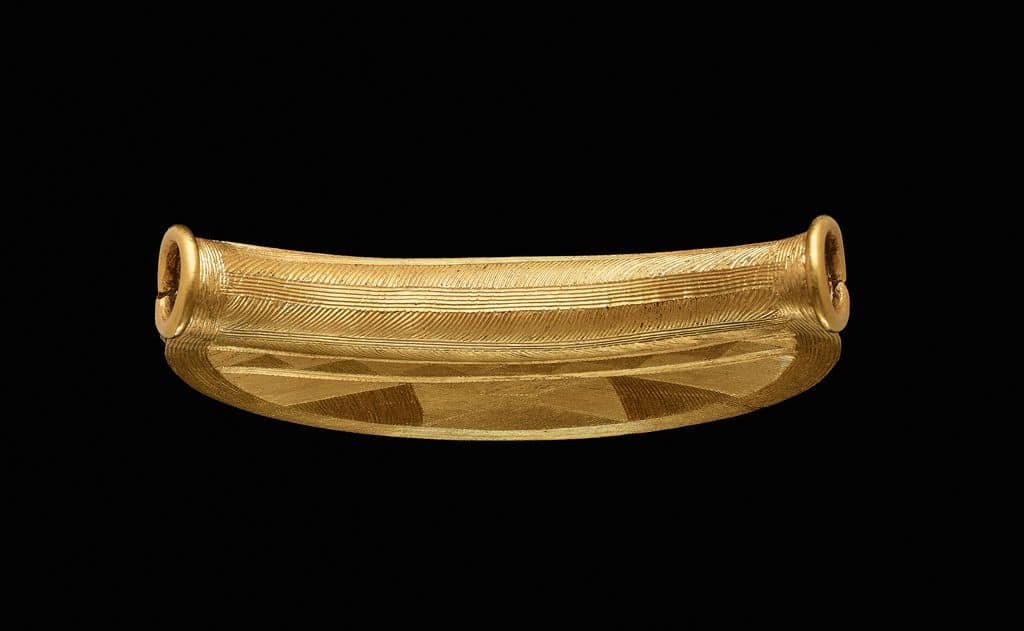
Full Sun Pendant Gathering Light Tour Announced
– Royal Cornwall Museum, Truro (6 August – 5 November 2022)
– The Collection, Lincoln (11 November 2022 – 20 February 2023)
– Sunderland Museum & Winter Gardens (25 February – 3 June 2023)
– Museum nan Eilean, Stornoway (13 June – 16 September 2023)
Supported by the Dorset Foundation
A British Museum Spotlight Loan Gathering light: A Bronze golden sun announces the full schedule of the tour, which gives an insight into the cosmology of Bronze Age Britain. A key component in the major The world of Stonehenge exhibition currently in its final week, the tour will travel to Truro, Lincoln, Sunderland and Stornoway between August 2022 and September 2023 with the support of the Dorset Foundation.

In Britain, the Bronze Age period lasted from around 2150BC until 800BC. Solar symbolism was a key element of mythology and belief during this period: the sun charted the day and provided life. This Spotlight Loan reveals the importance of the sun to the lives of Bronze Age ancestors, including the use of precious gold to depict the golden star and its centrality to their beliefs in this period.

Gathering light stars the previously announced extraordinary Shropshire sun pendant (HESH-43148A), which is over 3,000 years old, dating between1000–800BC in the late Bronze Age period. The sun pendant, also known as a bulla, with its elegant form and intricate decoration could be one of the most significant pieces of Bronze Age metalwork ever discovered in Britain. This spectacular object includes an exceptionally rare depiction of the sun – not previously seen on objects found in Britain. The pendant celebrates the life-giving power of the sun during the time of the earliest metalworkers and is a hugely significant addition to our understanding of the art and iconography of Bronze Age Britain.

The Spotlight Loan also features a stunning gold lunula (BCB62314), likely worn around the neck and dating from between 2400–2000BC, making it at least 4,000 years old. This crescent-shaped collar is named because it resembles a ‘little moon’. Discovered in a bog near Mangerton, Ireland in July 1842, this is one of only around 100 lunula examples that have been found in western Europe to date. Interestingly, over 80 of these ‘little moons’ come from Ireland, indicating a distinctively Irish cultural form. The collar was made by beating gold into a very thin sheet then decorated with a complex finely-incised geometric triangle pattern with considerable skill and was probably worn as jewellery or a ritual item. Such skilled craftsmanship and the presence of gold suggests that this lunula was aprestigious item. This type of object is absent from burials of the period, suggesting they were not associated with in single individual and may have been shared by communities. The social structure of Britain at this time does not appear to have been strongly or explicitly hierarchical.
Another gold bulla found in Ireland (BCB62490), dating between 1150–750BC and globular purse shaped rather than half-moon shaped, will also be on display as part of the Spotlight Loan. A similar age to the Shropshire sun pendant, the appearances and shape of the two bullas vary vastly. Similarly decorated with geometric patterns, though much less elaborate, it contains a cylindrical opening along the top which suggests it may have been worn as a pendant.

The exhibition includes the never before lent Towednack hoard, a series of gold objects discovered in Cornwall in 1931, fittingly showcased firstly at Royal Cornwall Museum. An ancient stone hedge concealed two torc necklaces, four arm rings and two pieces of unfinished gold material. Likely originating from Ireland, the objects date from 1400BC–1100BC, making them at least 3,100 years old. Uniquely, one of the torcs (BCB71356) consists of three twisted bars of fine gold, delicately woven together. The other larger gold torc (BCB71355), is much simpler and more typical of the type worn in Ireland. The bracelets would also have been commonplace, and remain in different stages of completion with two seemingly awaiting polishing and smoothing. The unfinished gold bars are bent, suggesting that they were raw material from a goldsmith intended to be a bracelet. Throughout the Bronze Age, Cornwall was a major source of metal (both gold and tin), and a key location for trade and exchange. Cornish tin and gold were traded far and wide, confounding any notion that the period was insular.

Completing the tour is an open-ended, gold plated ring (BCB84382) found in Londonderry, Northern Ireland. Also around 3,000 years old, the ring is made of tin alloy core, wrapped in gold foil and decorated with concentric rings of impressed dots. The pattern of vertical, parallel incisions on the outer edge is like that of the Shropshire sun pendant and shows parallels between Bronze Age communities.
Neil Wilkin, Curator, Early Europe at the British Museum said: “The Shropshire sun pendant is an internationally significant object, reflecting the artistic brilliance of communities from the deep past and the social and religious connections that spanned western Europe. Throughout the Bronze Age, Cornwall played a critical role in providing Britain, Ireland and Continental Europe with important raw materials, as well as producing stunning finished objects. The opportunity to bring the sun pendant to Cornwall, the source of so much material wealth and stylistic inspiration is therefore thrilling.”

A British Museum Spotlight Loan Gathering light: A Bronze Age golden sun will be on display at Royal Cornwall Museum, Truro from 6 August until 5 November 2022, The Collection, Lincoln between 17 November 2022 and 20 February 2023, Sunderland Museum & Winter Gardens from 25 February until 5 June 2023 and finishes at Museum nan Eilean from 13 June until 16 September 2023.










